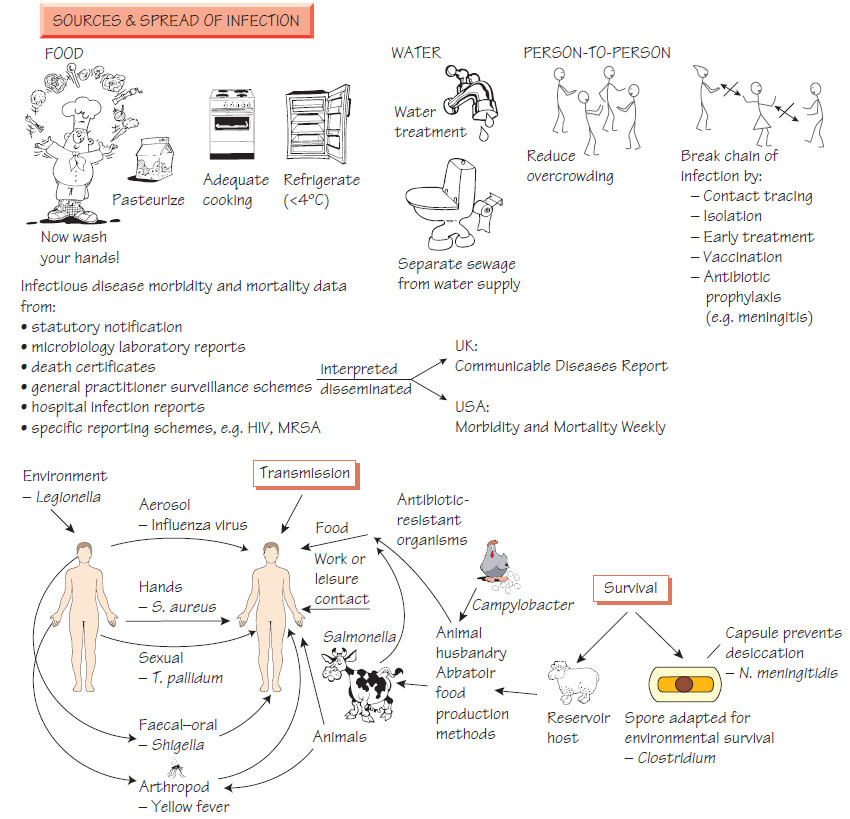Sources and transmission of infection
Sources of infectionInfection is caused either by organisms from the host's normal flora (endogenous infection) or by organisms transmitted from another source (exogenous infection).
Endogenous infection
The normal flora will only invade if circumstances permit, as in some of the following examples.
- Following bowel perforation Enterobacteriaceae and non-sporing anaerobes such as Bacteroides fragilis can invade the peritoneal cavity causing peritonitis and septicaemia.
- Inhalation of stomach contents may cause pneumonia, possibly followed by a lung abscess.
- Staphylococcus aureus that are normally found in the nose may cause wound infection if inoculated into a surgical wound.
- Neutropenic patients are especially prone to infection from organisms normally held in check by the body's defences.
- Surgery and intravenous cannulation allow skin organisms to invade.
The most important source of human infection is other humans. Some agents (e.g. measles) are more transmissible than others. An epidemic or outbreak can occur if each infected individual typically transmits the pathogen to more than one additional person.
Animal pathogens may be spread to humans by direct contact or in food. Such infections are called zoonoses and are encouraged by intensive farming methods that permit organisms hazardous to humans to spread within the herd or flock (e.g. bovine tuberculosis or E. coli O157). The risks increase with increasing intensity of farming: battery hens are especially prone to the spread of Salmonella and mechanized meat recovery techniques may increase the likelihood of cross-contamination. Feeding ruminant offal to cattle resulted in an epidemic of bovine spongiform encephalopathy (BSE), which then spread to humans as variant Creutzfeldt- Jakob disease (vCJD). The introduction of good farming and food factory techniques will reduce the risks of zoonoses. Humans can become infected from organisms in the inanimate environment. For example, poorly maintained air-conditioning cooling towers can be a source of Legionella pneumophila.
Microorganisms have evolved life cycles that facilitate their transmission and survival.
Organisms that cause diarrhoea, which are excreted in faeces, spread to other hosts by ingestion (faecal-oral route). More complex examples include organisms with a life-cycle stage inside an insect vector that allows transmission by a biting insect.
Organisms have developed specialist structures and behaviours to favour survival.
- Bacterial spores have a tough coat and low metabolic rate that enable them to survive for many years.
- Helminth eggs have a tough shell adapted for survival in the environment.
- The host can aid survival: when the infecting organism is able to persist for a long time in the host, this acts as a reservoir of infection.
Microorganisms propelled from the nose and mouth in a sneeze can remain suspended in the air on droplet nuclei (5 �m). Infection may occur when these are inhaled by another person and are carried to the alveoli. Respiratory infections such as influenza are transmitted in this way, but so are certain infections of other organs (e.g. Neisseria meningitidis).
Faecal-oral
Food and water contain pathogens that may infect the intestinal tract (e.g. Salmonella). Toxoplasmosis and cysticercosis, which infect organs remote from the gut, are also transmitted by this route.
- Leptospira, Treponema and Schistosoma have evolved specific mechanisms enabling them to invade intact skin.
- Injections, whether medical or for taking illegal drugs, and blood transfusions bypass the skin, allowing the transmission of a range organisms including the blood-borne viruses HIV and hepatitis B.
- Skin organisms (e.g. Staphylococcus epidermidis) can invade the body via indwelling venous cannulae.
Vector-borne
Insects that feed on blood may transmit a wide range of pathogens: most importantly female anophelene mosquitoes transmit malaria.
Sexual intercourse allows organisms with poor survival ability outside the body to be transmitted. Examples include Neisseria gonorrhoeae, Treponema pallidum and HIV. Transmission of HIV is enhanced by genital ulceration.





